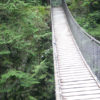The temperature did not warm up much from the breezy 13 degrees Fahrenheit during that frosty cold December morning at Rainbow Point at Bryce Canyon National Park; but every increase in degrees helped. The wind also started to subside upon accessing Yovimpa Point at Bryce Canyon National Park.
Yovimpa Point at Bryce Canyon National Park

Yovimpa Point and Rainbow Point conveniently share the same parking lot; so visitors can walk one third of one mile from one point to another in as few as five minutes.

Visitors must drive 18 miles from the entrance to get to the parking lot which Yovimpa Point and Rainbow Point share, which is located on a loop at the end of the main road of Bryce Canyon National Park.

Along with Rainbow Point — whose lookout is at an elevation of 9,115 feet — Yovimpa Point is one of the highest viewpoints in Bryce Canyon National Park.
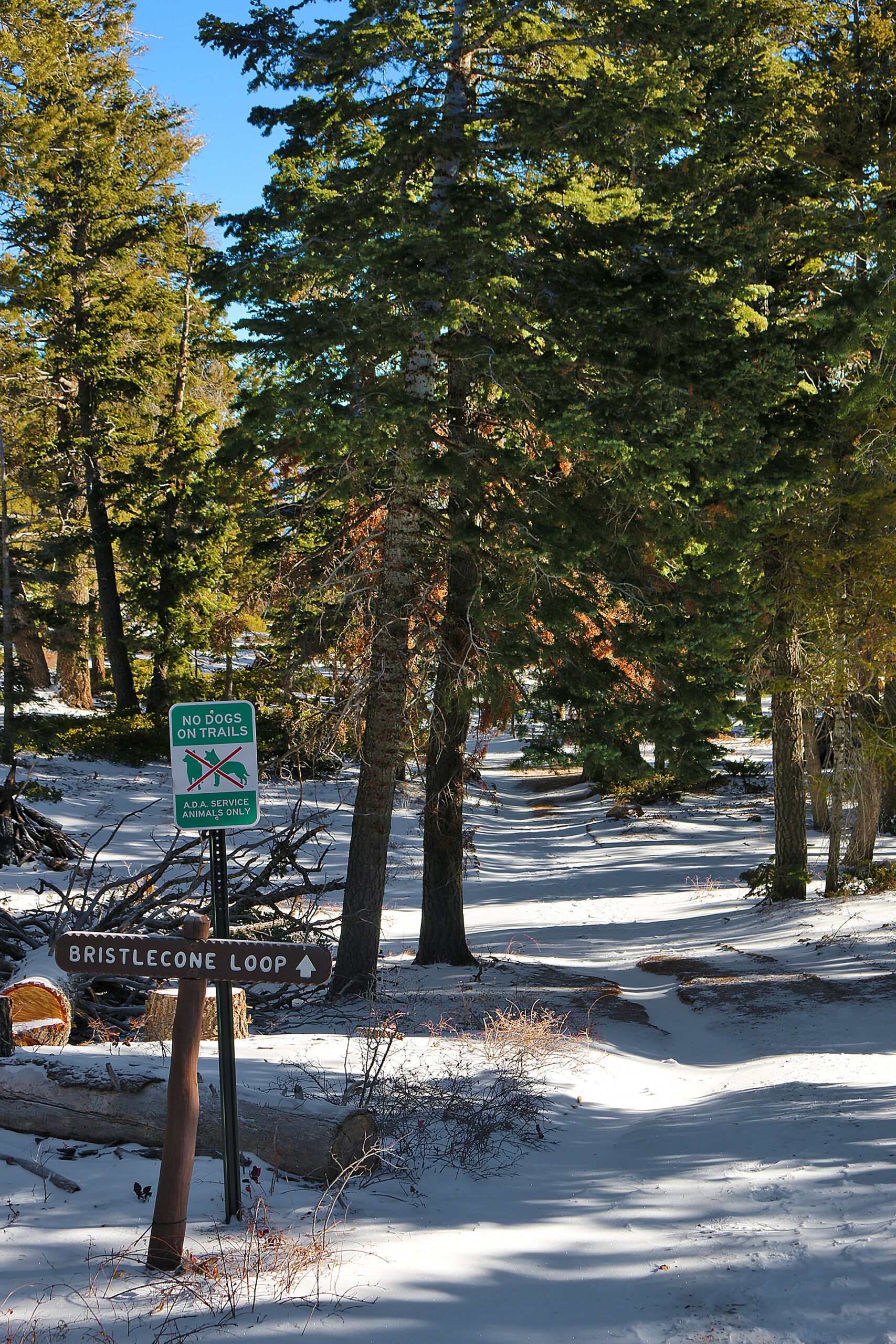
Access to Yovimpa Point via the Bristlecone Loop Trail is found on the sidewalk leading from the parking lot. Named for the forest of bristlecone pine trees through which it meanders, the length of Bristlecone Loop Trail is approximately one mile atop this highest portion of Bryce Canyon National Park. Visitors can also access the strenuous Riggs Spring Loop Trail — whose length is approximately 8.5 miles — from this point.

Fortunately, the short path which ascends from the parking lot to Yovimpa Point is well paved with wooden railings and easy to navigate for almost anyone.

The view in the photograph above faces southwest; and the following photographs will progressively face towards the south and then the southeast.

Over the course of the last 20 million years, this entire scene has been lifted due to tectonic uplift from sea level, to later be dissected by tributaries of the Colorado River.

Tilting that occurred during uplift has situated the southern end of the park approximately 1,000 feet or 304 meters higher than its northern end. From this point, one can gaze from the southern tip of the Paunsaugunt plateau and overlook the colorful cliffs of the Grand Staircase.
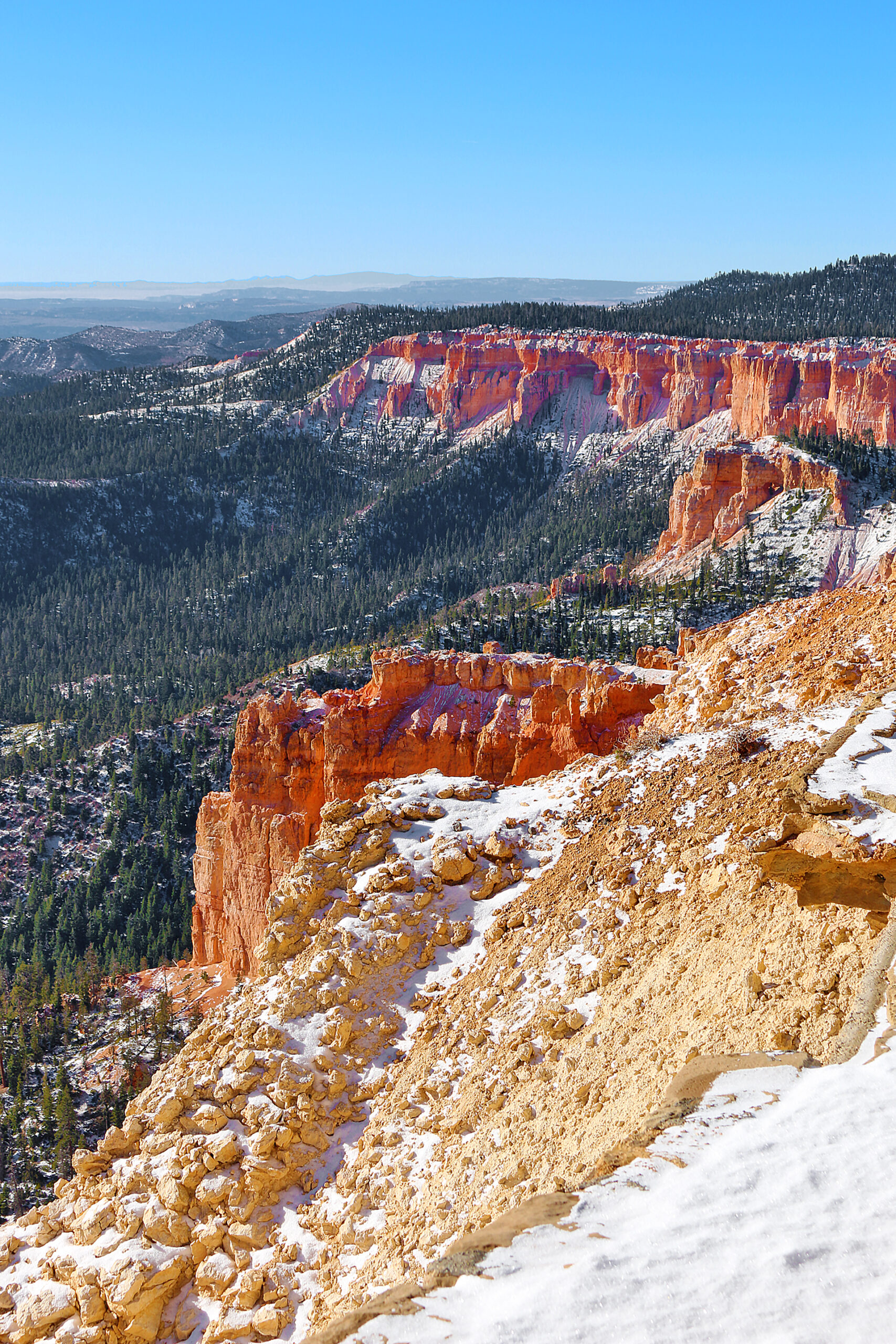
What are known as the Pink Cliffs of Bryce Canyon National Park are seen below and to either side of the expansive view. They are soft limey mudstones colored vibrantly by the chemical compound of iron oxide — which is also more commonly known as rust — and have been shaped into beautiful forms by rain and the power frost-wedging ice. Below them are the soft marine shales and silts of the Grey Cliffs, which are partially obscured by forest. Beyond these are deep canyons carved into the sandstones of the White Cliffs, which are also beautifully exposed at Zion National Park further west.

The Vermillion Cliffs and the Chocolate Cliffs — which are considered to be the bottom two “steps” of the Grand Staircase — are difficult to discern from the distance from Yavimpo Point. The horizon is the Kaibab Upwarp, which forms the northern rim of the Grand Canyon. The five cliffs of the Grand Staircase that extend from this point to the Kaibab Upwarp contain one of the most complete sedimentary records in the world of the last 300 million years of life and environment on the planet.

A vast forest of bristlecone pine trees — some of which are as old as 1,800 years old — is the main feature which comprises the view due south from Yavimpo Point.
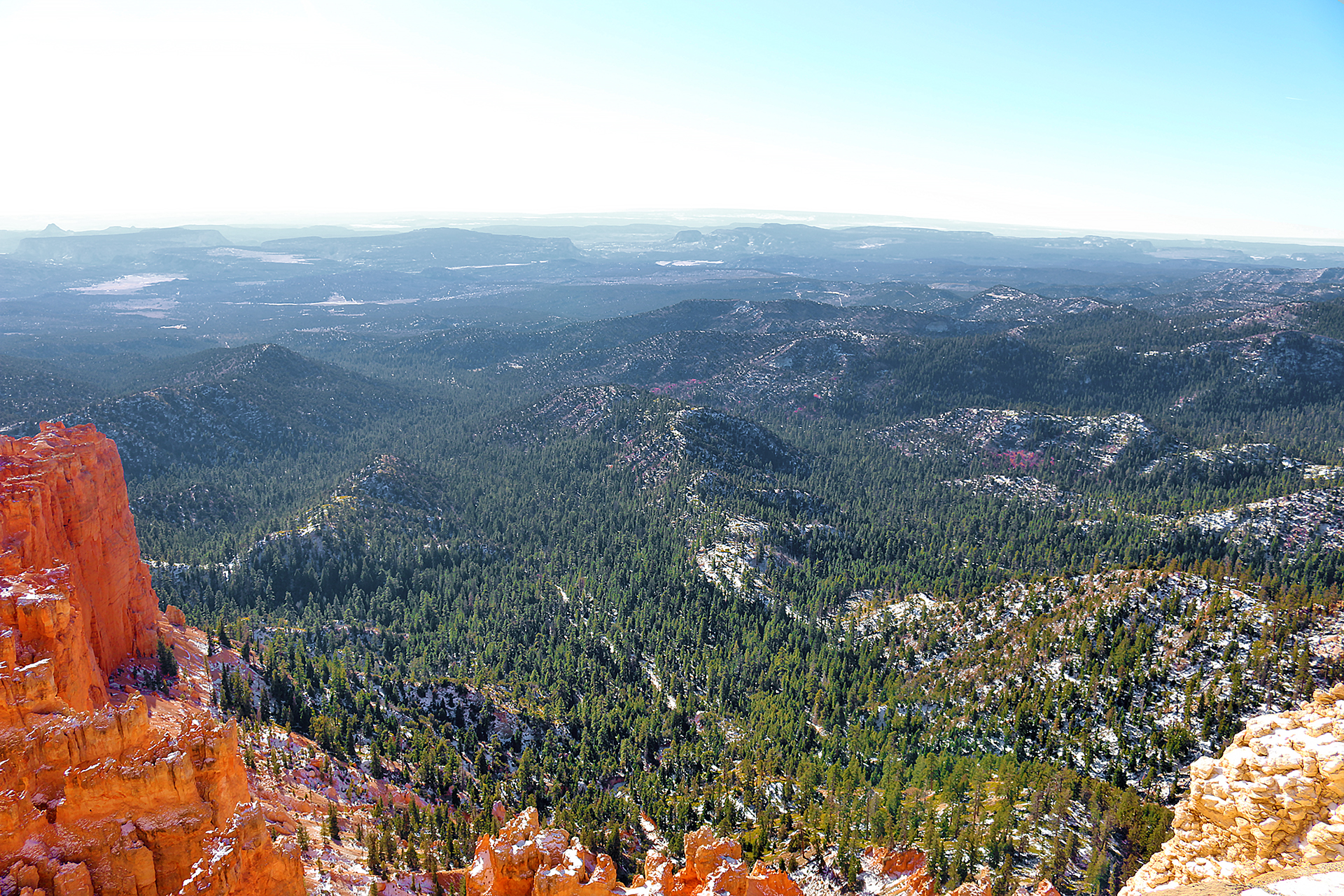
The view in the photograph above extends for greater than 100 miles or 161 kilometers, which is one of the grandest and longest views in Bryce Canyon National Park across the tops of the colorful “steps” — or cliffs — of the Grand Staircase.

When facing southeast, Navajo Mountain looms on the distant horizon greater than 80 miles away near Page in Arizona beyond the rugged massive — and strikingly vivid rich red — cliffs off of Yavimpo Point.
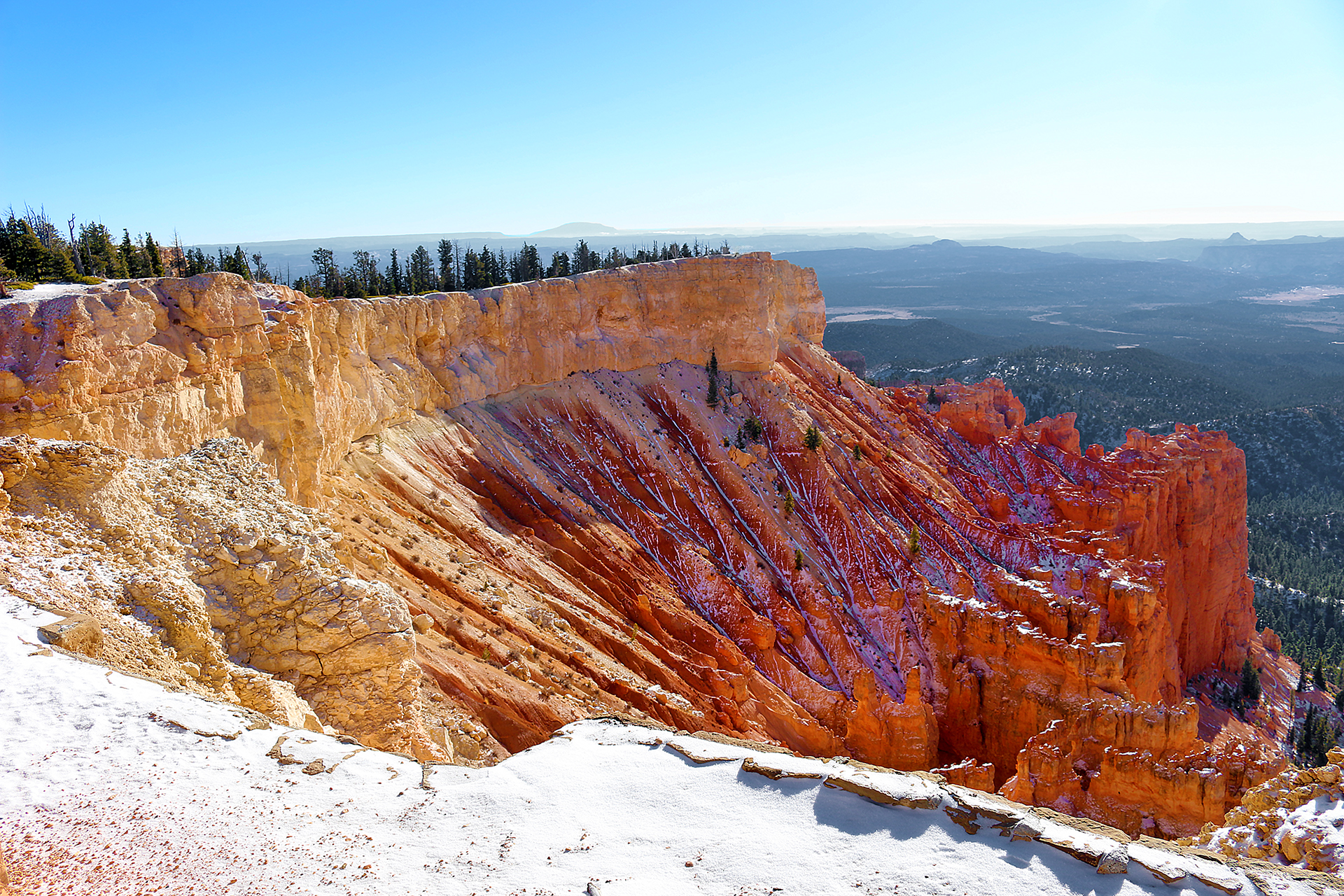
As the Colorado Plateau was uplifted by tectonic forces, a plume of molten rock moved upward from deep inside the Earth and caused a swelling — much like a large blister — which created a laccolith that is known today as Navajo Mountain. Think of it as a volcano that never quite happened. Unlike a volcano, Navajo Mountain never blew its top; so the plume cooled slowly, which created the hard core of the mountain that still exists today.

Final Boarding Call
As with almost anything else found at Bryce Canyon National Park, the views from Yovimpa Point were breathtaking.
Toilets are available for use near the parking lot of both Rainbow Point and Yovimpa Point.
Black Birch Canyon is the logical next stop after visiting Yovimpa Point.
Bryce Canyon National Park celebrated 100 years of existence in 2023; and it is open 24 hours per day, seven days per week.
Bryce Canyon National Park
P.O. Box 640201
Bryce, Utah 84764
435-834-5322
Credit cards are accepted.
All Weekly Passes are valid for seven days.
Weekly passes are non-transferable and are valid for seven consecutive days — including the date of purchase. Weekly passes may be upgraded to annual passes within seven days of purchase.
- Private Vehicle: $35.00. Admits private, non-commercial vehicle with a maximum capacity of 15 passengers and all occupants.
- Motorcycle: $30.00. Admits one non-commercial motorcycle.
- Per Person: $20.00. Admits one individual with no car. This weekly pass is typically used for bicyclists, hikers, and pedestrians. Youth 15 years of age and younger are admitted free of charge.
- Non-Commercial Organized Groups. Organized groups such as Scouts, Rotary, Clubs, Youth Groups, Churches, Reunions, etc. that do not qualify for an Academic Fee Waiver are charged as follows:
- $35.00 Admits private, non-commercial vehicle with a maximum capacity of 15 passengers.
- $20.00 per person for non-commercial vehicles with a minimum capacity of 16 passengers. Fees will not exceed the commercial fee for the same-sized vehicle. Youth 15 years of age and younger are admitted free of charge. Individuals or families with any valid Annual or Lifetime pass may use their pass for entry at the per person rate. The pass and photographic identification must be present upon entry.
Please refer to the National Parks of Utah and Colorado: Itinerary and Master Guide article — which is still a work in progress — for links to other articles at The Gate With Brian Cohen which pertain to the national parks of Utah and Colorado.
All photographs ©2020 by Brian Cohen.

